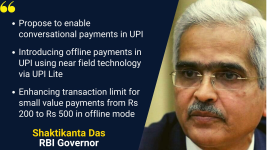Ya you are wrong.
India's UPI vs Brazil's Pix | How the 2-Year-Old Payment System Beats India's UPI:
We already know about India's UPI but do you guys know Brazil also have similar type of payment system called "Pix".
Brazil Pix is the only payment system that can challenge India's UPI across the globe.
Average transaction sizes. India's UPI is at Rs 1700, while Brazil's PIX is at Rs 7500
What is Brazil's Pix and How Brazil's Pix work -
Pix is the system created by the Brazilian Central Bank to bring instant payments to life and have been serving as a successful case story to other emerging markets. One year after its creation in November 2020, Pix increased 14,000% and, by January 2022, it was already used by 71% of the population in Brazil.
Brazil’s solution launched with many of the addressing features seen in UPI. The system allows users to select a phone number, e-mail address or other alphanumeric as their alias. User data is maintained in a centralized directory at the central bank of Brazil, as compared to the decentralized model of UPI’s domain-based addressing, in which data linking a person’s alias to their account is stored in their provider’s database.
How are Pix payments used ?
Pix transfers funds electronically between user accounts. Possible uses include:
- People who want to transfer money to others, like repaying a friend
- Individuals that need to pay for government services
- Businesses paying employees or freelancers
- Customers purchasing items at participating retailers, both in-person and online
- Businesses purchasing goods or services
Additionally, Pix fosters financial inclusion in Brazil by making payments accessible to Brazilians who don’t have a bank account. All you need is a personal Pix key.
How to use Pix ?
In order to use the Pix payments platform, each user sets up a unique Pix key.
There are four types of keys you can choose from: email address, cell phone number, CPF or CNPJ (individual taxpayer ID in Brazil), or a randomly chosen key. Once it’s created, that key becomes the user’s account for Pix transactions.
To register an address key, the user works with a financial institution to confirm and link the key to their account. Somebody can also set up an address key without registering it, which means even those who do not use a bank can still use this system.
Once an individual has their own Pix key, they can use it as a payment method for many transaction types. It works by providing either the individual’s address key information or by creating a scannable QR code to complete the transaction.
Once the transaction is initiated, the account holder can see the information and confirm the payment, providing a transparent checkout process for both parties.
How it works -
Online website through Desktop or offline merchants -
Online merchant user selects Pix at the checkout page
A QR Code is displayed on the screen or offline payment scan the merchant QR code
The user scans the QR Code using his smartphone
The details of the transaction are displayed for confirmation
Mobile -
Choose Pix at the checkout and copy the Pix code
Open the internet banking app to pay with Pix
Select “Pix Copia e Cola” to paste the code
Confirm the payment!
Great exchange rates and low fees
Because the Pix payment platform uses the Brazilian real (BRL), any overseas currency will be converted to BRL when transferred through the platform.
So, if you’re sending money from the U.S. to Brazil, for example, you’ll want to keep an eye on the exchange rate between the U.S. dollar (USD) and the BRL.
Pro tip: Remitly offers a promotional exchange rate for your first transfer to Brazil, to help more money make it home.
Success store -
Pix beats cards in transactions for first time -
In under two years, PIX has become the most popular form of payment in Brazil, surpassing credit and debit cards.
The number of transactions through Pix surpassed those with credit or debit cards in the fourth quarter. It was the first time that the Central Bank’s instant-payment system took the first position among the most used payment methods.
According to the most recent data from the Central Bank, transactions via Pix totaled 3.89 billion in the last three months of last year, up 34% over the previous quarter. In cards, transactions also grew, but at a slower pace. There were 3.85 billion transactions using debit cards (up 9%) and 3.73 billion through credit cards (up 12%). Prepaid cards advanced 20%, to 1.92 billion transactions.
Today, instant transfers are so ubiquitous, Brazilians use them tens of millions of times a day, for everything from paying the rent to buying groceries to giving money to beggars on the street.
Walking amid cars stopped at a red light in São Paulo, panhandler Robson Ferreira has been a first-hand witness to the revolution the system has wrought in Latin America's largest economy.
"I usually get more money in PIX than cash," says the 48-year-old unemployed man, carrying a hand-scrawled sign that says, "Need help. Accept PIX."
Below that is a number drivers and passersby can use to deposit money directly into his account, a process that takes seconds on a cell phone.
"People told me, 'We don't even carry money any more. Put your PIX on there,'" Ferreira says.
PIX is so popular it has become a campaign issue in Brazil's October elections, with President Jair Bolsonaro claiming the credit for it – though in reality work on the system began under former president Michel Temer (2016-2018).
Bolsonaro's top opponent, leftist ex-president Luiz Inácio Lula da Silva (2003-2010), has meanwhile been a target of a disinformation campaign, with false reports he plans to kill PIX to protect big banks, whose commissions on electronic transfers have evaporated since the system was launched.
Replacing cash -
Available 24/7, PIX allows anyone with a bank account to send and receive money instantly.
All senders need is a banking app on their smart phones and the "key" for the destination account – usually a phone number or taxpayer ID.
Some cash registers and payment terminals also let users scan a QR code that makes payment even faster.
For now, PIX is still used mainly for small transactions
On the beach in Rio de Janeiro, where he makes his living selling coconuts – including by PIX – José Jefferson sees another advantage.
"PIX is a lot safer. With cash, there's more risk it gets lost or stolen," he says.
Future of Brazil's Pix -
Brazil central bank chief predicts death of Visa and Mastercard credit cards -
Brazil’s central bank chief Roberto Campos Neto believes Visa and Mastercard credit cards are on the brink of extinction due to growth in account-to-account based open payments.
Brazil's banks have already started using Pix to offer credit.
According to Campos Neto, Pix could first expand “at least” to Latin America. He said Canada has also shown interest in the Pix system.
Already many US and European websites and crypto exchange accept Brazil's Pix payment system, more International merchants are interested to accept payment through Brazil's Pix for Brazilians.
Recent News, 26 July 2023 -
Brazil's Pix used for more transactions than credit and debit cards combined.
Launched in late 2020 by the Central Bank of Brazil, account-to-account payment option PIX saw transactions for Q1 hit 8.1 billion, compared to 4.2 billion for credit cards and 3.8 billion for debit cards.
Data from the central bank, reviewed by vendor Matera, shows that Pix accounted for 35% of all transactions in Q1, up from 23% a year ago. In contrast, credit card transactions were 18% of the total, down from 20% one year ago. Debit card transactions were 16% of total, down from 20%.
QR codes are proving an important part of the Pix success story, accounting for nearly 30% of the platforms transactions.






